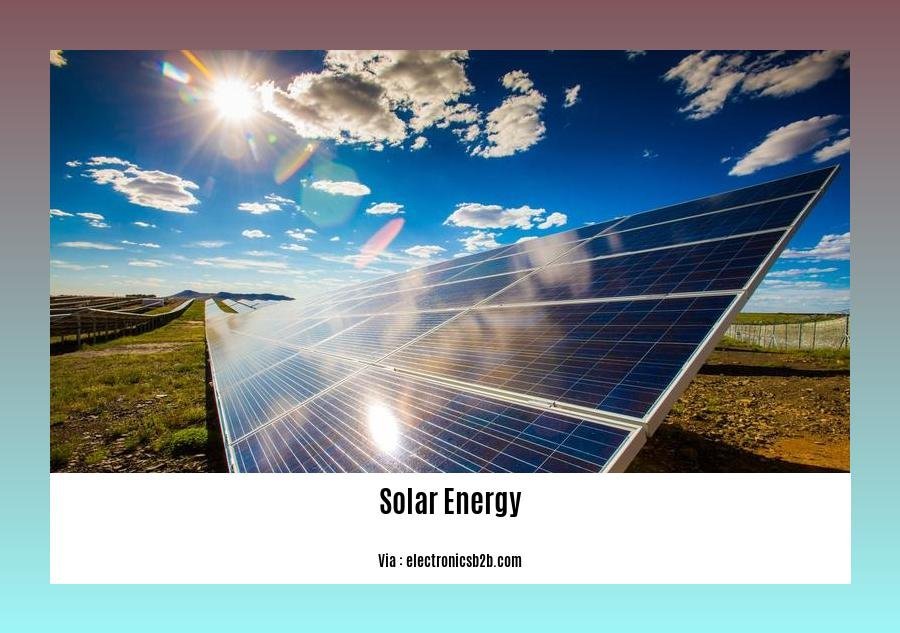Exploring the Endless Possibilities: Everyday Life Uses of Solar Energy
Unleashing the power of the sun has become more than just an abstract concept; it has gracefully woven its way into the tapestry of our daily lives. Solar energy, once considered novel and futuristic, is now a remarkable reality that presents boundless opportunities to revolutionize how we navigate through our everyday routines. Embracing the immense potential of solar energy as a renewable and sustainable solution, we find ourselves on the brink of an awe-inspiring journey rooted in the very essence of our existence. From powering our homes and transportation to enhancing our outdoor encounters, solar energy has transcended its limitations, illuminating a path towards a brighter, cleaner and more conscious future.
Key Takeaways:
- Solar energy is utilized in solar cookers, which efficiently and sustainably cook food, reducing reliance on traditional methods and mitigating carbon footprint.
- Solar stills use the sun’s heat to convert saline water into drinkable water, providing a valuable solution for regions with limited access to clean water sources.
- Photovoltaic cells convert solar energy into electrical energy, powering various devices from pocket calculators to large-scale power generation.
- Large-scale solar installations contribute to power generation, reducing reliance on nuclear and fossil fuel power plants and creating a more sustainable energy system.
- Solar energy is also used in smaller-scale applications such as lighting road signs and operating pocket calculators, showcasing its versatility and ability to power everyday devices.
- Solar energy has transformed daily life by providing sustainable and clean alternatives to traditional energy sources.
Everyday Life Uses of Solar Energy

Solar energy has become an essential power source in our daily lives, providing sustainable and eco-friendly solutions to meet our energy needs. From cooking food to powering devices, solar energy offers endless possibilities for a greener and more sustainable future. Let’s delve into the everyday life uses of solar energy and how it can revolutionize the way we live.
Solar Cookers: Harnessing the Sun’s Power for Sustainable Cooking
Cooking with solar energy has gained immense popularity, and for good reason. Solar cookers harness the power of the sun to create heat, allowing us to cook food efficiently and sustainably. With the use of reflective surfaces and a solar collector, these cookers capture sunlight and convert it into usable heat. Not only does this reduce our reliance on conventional cooking methods, but it also helps reduce our carbon footprint, making it a win-win solution for our everyday lives.
Solar Stills: Transforming Saline Water into Drinkable Water
Access to clean drinking water is a basic necessity, yet many regions struggle with limited resources. Solar stills come to the rescue by utilizing the sun’s heat to evaporate water, which then condenses and can be collected as freshwater. This application of solar energy is particularly crucial in areas with limited access to clean water sources. With solar stills, we can transform saline or contaminated water into safe and drinkable water, providing relief to communities that face water scarcity.
Photovoltaic Cells: Harnessing the Power of the Sun for Electricity
When it comes to converting solar energy into electrical energy, photovoltaic cells are the key players. These cells use the sun’s photons to generate an electrical current, offering a sustainable source of power for various devices. From small gadgets like pocket calculators to large-scale power generation, photovoltaic cells have a wide range of applications. By utilizing solar energy, we can power our devices while reducing our reliance on traditional energy sources and minimizing our impact on the environment.
Supplementing Conventional Power Plants: Large-Scale Solar Installations
Solar energy also contributes to power generation on a larger scale. Large-scale solar installations are increasingly being used to generate electricity, reducing our dependence on nuclear and fossil fuel power plants. These solar farms harness the sun’s energy to produce electricity, thereby reducing greenhouse gas emissions and creating a more sustainable energy system. By supplementing conventional power plants with solar energy, we pave the way towards a cleaner and brighter future.
Illuminating Road Signs and Powering Everyday Devices
Solar energy has the versatility to power smaller-scale applications as well. It is used to light up road signs and operate everyday devices such as pocket calculators. These applications highlight the accessibility and adaptability of solar energy in our daily lives, making them more energy-efficient and environmentally friendly. By incorporating solar-powered solutions into our everyday activities, we can actively contribute to a more sustainable and greener world.
In conclusion, solar energy offers us endless possibilities in our everyday lives. From cooking food sustainably to transforming saline water into fresh drinking water, and from powering our devices to supplementing conventional power plants, solar energy is a game-changer. By making use of the abundant and renewable energy from the sun, we can create a more sustainable future for generations to come.
References:
1. BYJU’s: Uses of Solar Energy in Daily Life
2. Sciencing: Uses of Solar Energy in Daily Life
Land pollution in Zimbabwe has severe effects on the environment and human health. Discover the impacts of land pollution in Zimbabwe by clicking here.
Wind energy is not only a sustainable solution but is also found in everyday life. Explore some captivating examples of wind energy in everyday life by clicking here.
Solar-powered transportation: Exploring the potential of solar vehicles
Solar vehicles powered by the sun’s energy are paving the way for a cleaner and more sustainable future in transportation. These innovative vehicles have the potential to revolutionize the way we travel, reducing our reliance on fossil fuels and minimizing greenhouse gas emissions. In this article, we will delve into the endless possibilities that solar-powered transportation offers and explore the potential of solar vehicles in various contexts.
The Potential of Solar Cars:
A recent study modeling the potential of solar-powered vehicles in 100 cities worldwide has shed light on the remarkable benefits they can offer. By harnessing solar energy, these cars can provide a range between 11 and 29 kilometers per day, effectively cutting the need for charging in half. This not only saves time but also reduces the cost of charging. Imagine the convenience of being able to travel significant distances without worrying about constantly recharging your electric vehicle!
However, despite the positive outlook, the production of a reliable and commercially viable solar car remains a challenge. Numerous companies are racing to be the first to release a reliable model that meets the demands of everyday use. The development of a solar vehicle that is efficient, affordable, and practical for everyday transportation is the key to unlocking its full potential.
Beyond Cars: Solar-powered Trains and Roads:
The potential of solar vehicles extends beyond cars alone. There are possibilities for solar-powered trains and even solar roads, offering alternative solutions for sustainable transportation. Solar-powered trains utilize photovoltaic panels to generate energy for propulsion, reducing carbon emissions in the transportation sector. Furthermore, solar roads integrate solar panels into the road surface, turning highways into power-generating sources. These advancements have significant implications for reducing CO2 emissions and creating a greener transportation infrastructure.
Key Takeaways:
- Solar-powered transportation has the potential to revolutionize the way we travel, reducing our reliance on fossil fuels and minimizing greenhouse gas emissions.
- Solar cars can provide a range of 11 to 29 kilometers per day, cutting the need for charging in half and offering cost-saving benefits.
- The production of a reliable and commercially viable solar car remains a challenge, with several companies competing to create a model that meets everyday transportation demands.
- Solar-powered trains and roads are additional avenues for sustainable transportation, reducing CO2 emissions and creating a greener infrastructure.
Sources:
– Tech Xplore
– CleanTechnica
Solar Energy for Outdoor Activities: Portable Solar Chargers and Camping Equipment

Whether you’re camping, hiking, or simply enjoying the great outdoors, having access to power can make a significant difference in your experience. With the advancements in solar technology, harnessing the power of the sun has become easier and more accessible than ever. Portable solar chargers and camping equipment powered by solar energy are revolutionizing outdoor activities, providing a sustainable and reliable source of power.
Exploring the World of Portable Solar Chargers
Portable solar chargers are designed to charge devices such as smartphones, cameras, and GPS devices in locations without traditional power sources. These compact devices, equipped with solar panels, utilize the abundant energy of the sun to provide a continuous power supply. They typically feature a built-in battery and USB ports, allowing you to store and harness solar energy for charging your devices even when the sun isn’t shining.
But which portable solar chargers are the best choices for outdoor enthusiasts? Let’s take a look at some of the top options recommended by experts in 2023:
-
X-Dragon 20W: This fast-charging portable solar panel offers quick and reliable power for all your devices, while maintaining a small and convenient package[^1^].
-
Jackery SolarSaga 100: Considered the best overall 100-watt solar charger for camping, this device provides high-wattage output and exceptional reliability[^1^].
-
BigBlue SolarPowa 28: Among smaller panels, this charger stands out as the best overall portable solar charger, offering convenience and portability[^1^].
-
FlexSolar 40W: With its medium-capacity setup, this portable solar charger is easy to use and provides high-output charging. It can quickly unfold from a compact size, making it a versatile choice[^1^].
-
BigBlue SolarPowa 100 ETFE: This charger offers larger solar panels, providing increased charging capacity and the best value for 100+ watt solar chargers[^1^].
In addition to these top picks, GearLab and other reputable sources provide comprehensive reviews and buying guides for solar chargers, offering valuable information to help outdoor enthusiasts make informed decisions[^2^] [^3^] [^4^].
The Benefits of Portable Solar Chargers for Your Outdoor Adventures
Portable solar chargers offer numerous advantages for outdoor activities, making them an essential companion for your adventures. Here are some key takeaways:
-
Sustainable Power Source: By harnessing the clean and renewable energy of the sun, portable solar chargers contribute to reducing our carbon footprint and dependence on traditional power sources.
-
Ease of Use: Portable solar chargers are designed to be user-friendly, with simple setups and intuitive interfaces. They can be easily folded, unfolded, or attached to backpacks, making them convenient to carry and use on the go.
-
Fast Charging: Top-rated portable solar chargers provide efficient and fast-charging capabilities, ensuring that your devices are powered up and ready to go in no time.
-
Portability: With their compact and lightweight designs, portable solar chargers can be easily transported and stored in your backpack or camping gear. They are specifically built to withstand outdoor conditions, including water resistance and durability.
-
Reliability: When you’re out in nature, you can’t always rely on traditional power sources. Portable solar chargers offer a reliable power supply, allowing you to stay connected and powered up wherever your adventures take you.
Conclusion
Solar energy for outdoor activities has become a game-changer, thanks to portable solar chargers and camping equipment. These innovative devices provide a sustainable and accessible solution for powering your devices while exploring the great outdoors. With the best solar chargers of 2023 offering fast-charging capabilities, portability, and reliability, outdoor enthusiasts can enjoy their adventures without worrying about running out of power. Comprehensive reviews and buying guides from reputable sources can help you select the right solar charger for your specific outdoor activities. Embrace the power of the sun and enhance your outdoor experience with portable solar chargers and camping equipment.
Key Takeaways:
-
Portable solar chargers offer a sustainable and reliable power source for outdoor activities.
-
Top-rated portable solar chargers for 2023 include the X-Dragon 20W, Jackery SolarSaga 100, BigBlue SolarPowa 28, FlexSolar 40W, and BigBlue SolarPowa 100 ETFE.
-
Portable solar chargers provide fast charging, portability, ease of use, and reliability.
-
Comprehensive reviews and buying guides from reputable sources help outdoor enthusiasts make informed decisions.
Sources:
[^1^]: GearLab – Best Solar Chargers of 2023
[^2^]: GearLab – The 5 Best Portable Solar Chargers of 2023
[^3^]: Outdoors Generations – Best Solar Charger for Camping of 2023
[^4^]: Treehugger – The 7 Best Portable Solar Panels of 2023
Solar energy in everyday products: Solar-powered gadgets and appliances
Solar-powered gadgets and appliances have revolutionized the way we utilize energy in our everyday lives. These innovative devices harness the power of the sun, offering eco-friendly alternatives to traditional power sources. From portable chargers to outdoor lighting, solar energy is making its way into various aspects of our daily routines.
Portable Solar Chargers: Power on the Go
Portable solar chargers are a game-changer for individuals who are always on the move. With built-in solar panels, these chargers convert solar energy into electricity, allowing you to charge your smartphones, tablets, and other gadgets wherever you are. X-Dragon 20W and Jackery SolarSaga 100 are among the top-rated options for fast-charging capabilities and reliability [^1^].
Solar Cooking: Sustainable and Flavorful Meals
Say goodbye to conventional cooking methods and embrace the power of the sun with solar cookers. These gadgets use solar energy to cook food efficiently and sustainably, reducing our reliance on gas or electricity. Solar cookers are perfect for outdoor picnics, camping trips, or simply enjoying the great outdoors while preparing a delicious meal.
Solar Water Heaters: Eco-Friendly Pool Comfort
Swimming pool owners can also benefit from the magic of solar energy. Solar water heaters for swimming pools offer a sustainable solution to heating pool water, especially in colder climates. By harnessing the sun’s energy, these heaters provide heated pools without the need for traditional fuel sources. Now you can enjoy a warm swim while reducing your carbon footprint.
Solar Outdoor Lighting: Illuminating the Night
Solar outdoor lighting brings both functionality and aesthetics to your outdoor spaces. These lights store solar energy during the day and automatically illuminate at night, providing an eco-friendly and cost-effective lighting solution. Whether it’s for your garden, patio, or pathway, solar outdoor lighting offers a sustainable way to brighten up your surroundings.
Key Takeaways:
- Solar-powered gadgets and appliances offer sustainable and eco-friendly alternatives to traditional power sources.
- Portable solar chargers, such as X-Dragon 20W and Jackery SolarSaga 100, allow you to charge your devices on the go.
- Solar cookers use the sun’s energy to cook food efficiently and sustainably, perfect for outdoor adventures.
- Solar water heaters provide heated pools without relying on conventional fuel sources, reducing your carbon footprint.
- Solar outdoor lighting offers a cost-effective and environmentally friendly way to illuminate outdoor spaces.
Sources:
[^1^]: GearLab – Best Solar Chargers of 2023
FAQ
Q1: How is solar energy used in cooking food?
A1: Solar energy is used in cooking food through the use of solar cookers, which capture sunlight and convert it into heat. This allows for efficient and sustainable cooking, reducing reliance on traditional fuel sources.
Q2: What is the benefit of using solar energy to convert saline water into drinkable water?
A2: The benefit of using solar energy to convert saline water into drinkable water is that it provides a sustainable solution in regions with limited access to clean water sources. Solar stills use the sun’s heat to evaporate water, which then condenses and can be collected as fresh drinking water.
Q3: How do photovoltaic cells contribute to electrical energy production?
A3: Photovoltaic cells harness the sun’s photons and convert them into electrical current, providing a sustainable source of energy. These cells are used in various devices, from small gadgets like pocket calculators to large-scale power generation, reducing the reliance on conventional power plants.
Q4: How does solar energy contribute to power generation?
A4: Solar energy contributes to power generation by using large-scale solar installations to generate electricity. This reduces the dependence on nuclear and fossil fuel power plants, leading to a more sustainable energy system and a decrease in greenhouse gas emissions.
Q5: What are some examples of smaller-scale applications of solar energy?
A5: Some examples of smaller-scale applications of solar energy include lighting road signs and operating pocket calculators. These applications showcase the versatility of solar energy and its ability to power everyday devices, making them more energy-efficient and environmentally friendly.
- Unveiling the Enigma: Mansoureh Khojasteh Bagherzadeh’s Public Appearances & Private Life in Iran - July 18, 2025
- Unveiling the Mystery: Mansoureh Khojasteh Bagherzadeh’s Husband: A Rare Glimpse into a Private Life - July 18, 2025
- Unveiling Masoud Khamenei’s Mother: Power, Influence, and Iran’s Future - July 18, 2025
















